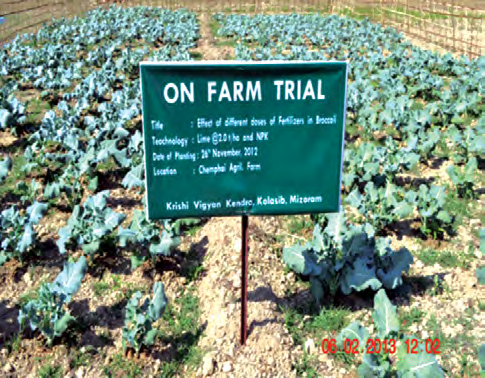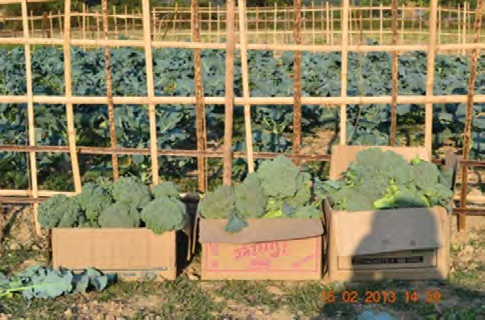Benefits of Balanced Fertilization in Cultivation of Broccoli
Benefits of Balanced Fertilization in Cultivation of Broccoli
Broccoli (Brassica oleracea var italica) is a winter season vegetable crop. The word broccoli from the Italian plural of broccolo refers to ‘the flowering top of a cabbage’. It is an edible green plant in the cabbage family whose large flower head is used as vegetable. It is cherished for its delicious taste, flavour and nutritive value and has been reported to prevent cancer. It is a recent introduction to India but is becoming popular among the rich people because of its low fat content, low in calories, high vitamin C and good source of vitamin A, vitamin B2 and calcium (Decoteau, 2000).
Problem of imbalanced fertilisation
Like other vegetable crops of the family, it removes large quantity of major nutrients from the soil. However,continuous application of huge amount of chemical fertilizers hampers the soil health and generates pollution. Broccoli plants are heavy feeders and will do well with a dose of fertilizer every couple of weeks. Application of balanced fertilizer shows a better result which gives the plants enough energy to get large enough to support full heads of broccoli. The integrated nutrient management paves the way to overcome these problems, which involves conjunctive use of chemical fertilizers and organic manures to sustain crop production as well as maintenance of soil health (Nanjappa et al., 2001). The use of lime in combination with chemical fertilizers and organic manures offers a great opportunity to increase the production of broccoli with less cost.
Continuous Imbalanced Fertilization leads to:
- Depletion in soil fertility
- Decrease in crop yields
- Poor crop quality
- Diminishing profits
Need for balanced fertilization
In Kolasib district of Mizoram, the cultivation of broccoli crop in rabi season is usually cultivated with an imbalanced fertilizer use which have resulted in multiple nitrogen (N), phosphorus (P), potassium (K) and other nutrient deficiencies. For intensive, high yielding cropping systems, current recommended NPK rates are inadequate and need revision upwards. Hence, there was a need to develop a suitable integrated nutrient management module for improving productivity and quality of broccoli.
Crops need many essential nutrients for optimum growth, yield and quality. Nitrogen (N), phosphorus (P), potassium (K), sulphur and zinc are some of the essential plant nutrients. Crops need N, P and K in large amounts; hence these are applied through fertilizers. Application of plant nutrients in optimum ratio and adequate amounts is called “Balanced Fertilization”. Balanced Fertilization is the proper supply of all nutrients (macros and micros) throughout the growth of a crop.


Benefits of Balanced Fertilization:
- Increased yield
- Increased crop quality
- Maintaining or improving soil fertility
- Improving the quality of the environment: soils, ground / surface waters, etc.
Practices followed
The soil was pulverized at the right tilth and levelled. Well rotten farm yard manure (FYM) at 10t/ ha was thoroughly incorporated in top soil at the time of field preparation. The seedlings (28 days old) of Broccoli-var. Big Head were transplanted maintaining a spacing of 50 x 45 cm.
A light irrigation was given to each plot immediately after planting and subsequent irrigations were applied as per need. Plant population was maintained by gap filling after 6-9 days of transplanting. Slaked lime was broadcast @2.0 t/ha before two weeks of sowing and thoroughly mixed with soil at the time of ploughing. Balance chemical fertilizer i.e. 100 kg nitrogen, 80 kg phosphorus and 100 kg/ha potassium was supplied by urea, single super phosphate (SSP) and muriate of potash (MOP), respectively. Full dose of phosphorus, potash and1/3rd of nitrogen as common dose and remaining 2/3rd of nitrogen was applied at 30 and 45 days after transplanting as top dressing and earthing was done.
In order to make the field free from weeds, two manual weedings were done. Heads are harvested after attaining proper size but before opening of buds.
Observations were recorded on 15 randomly chosen plants; for N: P: K status soils were sampled with an auger with 5 cm internal diameter in the plough layer (0–20 cm) at five randomly selected locations and then mixed as one sample. All fresh soil samples were air-dried and sieved through a 2.0 mm and 0.25 mm sieve and stored for nutrient analysis before planting and after harvesting of crop. Soil pH was recorded before planting and after harvesting with glass electrode in a 1 : 2.5 soil/water suspension method.
The effect of Balanced Fertilization on NPK status, pH value, Head weight, yield and B: C
| Initial pH | After Harvest pH | Before harvest NPK status (kg/ha) | After harvest NPK status (kg/ha) | Head weight(gms.) | Yield-q/ha | B:C ratio |
|---|---|---|---|---|---|---|
| 5.3 | 6.1 | 279:18.92:123 | 281.6:16.20:119.4 | 460 | 63.5 | 1: 3.14 |
Conclusion and Recommendation
From the above result, integrated nutrient management with lime application along with chemical fertilizer dose of (100:80:100kg/ha) and FYM showed the highest head weight (460gms.) and the gross yield of the crop. The physical appearance of the curd makes the crop more preferable for market linkage.

The pH of the soil has significantly increased from 5.3 to 6.1. There was a slight increase in the content of Nitrogen whereas in case of Phosphorus and Potassium there was a reduction from the initial as due to fixation of P and K in the form of chelates by Fe and Al, uptake of nutrients by the crop and weeds and loss due to runoff/ leaching from heavy rainfall in the region overall resulting in reduction of crop yield.
Last Modified : 3/1/2020
